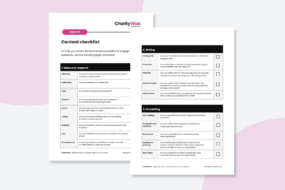
Charities can often have a hard time making their voice heard, but having an active blog on your website is a great way to reach a wider audience and build support for your charity.
In this guide, we will show you how to get the most out of your blog by creating helpful and engaging content that is written with your charity’s goals and audience’s needs in mind.
Why create blog content?
Blog content can provide valuable insights into your charity and help raise awareness of your cause. It can highlight the work that you do, share fundraising targets, and feature the people or services that you support.
Around 6 in 10 charities have a blog section on their website, in varying formats. Whilst there is not a formula for success, a good charity blog publishes content that demonstrates expertise. It ensures that the blog section becomes the go-to resource for anyone looking for information about your charity.
Who am I writing content for?
Knowing your audience and understanding their needs is fundamental when planning blog posts for your website.
If you already have personas for your key user groups, you can use these to guide the planning and research process. If you don’t have clearly defined audiences, follow our guide to creating personas, which will help you to understand your users’ needs, experiences, behaviours, and goals.
By gaining a deeper insight into your audience, you can ensure you are answering the right questions and providing the information they need.
What should I write about?
As a starting point, read our Introduction to content strategy guide, which explains the importance of having a content strategy to plan, produce, and publish successful content.
Taking into account your audience’s needs and charity’s goals, you can start to research and plan content ideas for your blog. Remember, it’s about quality over quantity when it comes to creating content.
You could:
- Explain important things about your charity in more detail
(the cause you are supporting, how to volunteer)
- Tell people what you’re up to
(conducting new research, supporting specific groups)
- Are there any frequently asked questions by supporters?
- Review any enquiries you receive. Can these questions be addressed on your website?
- Share any relevant internal research, reports and data
- Write Q&As with people that work at your charity or benefit from your services and support.
Some charities create content with search engines in mind, hoping to generate traffic through organic search. Whilst it is important to consider SEO practices, avoid writing content solely with the goal of ranking in search results. This type of content usually lacks expertise and does not provide value to readers
Top tip: If you have an internal search function on your website, track the keywords that people are searching for on Google Analytics and include these topics in your blog posts.
Different content formats
It is important to diversify your blog with different types of content. If your blog currently has a lot of long form posts, you could test some shorter format posts, Q&A style articles, and video content to make information more engaging and easier to digest.
Also keep in mind that users might be viewing your blog posts on a mobile device such as a phone or tablet rather than a desktop, so ensure that your blog is optimised for mobile.
How to make posts more engaging:
- Use bullet points to break up more detailed sections
- Use numbered lists
- Shorter paragraphs with clear headings
- Use iconography and illustrations
- Include high resolution imagery
- Use graphs and visuals for data
Evergreen content
Try to make most of your blog content evergreen, ensuring that content is always relevant to your audience. Examples of evergreen content could be ‘how to become a volunteer’, or a post that informs readers about a recent cause that you supported.
A ‘News’ section on your website could be used to update readers with time sensitive information or details that are still unfolding, such as fundraising targets or reactions to current events. This ensures that your website is always providing the most relevant and up-to-date content for users.
Writing content
When it comes to writing content, everyone needs to follow brand and tone of voice guidelines to make sure blog posts are consistent and express your charity’s brand identity.
When your team or contractor starts writing, it is important that they use Plain English and inclusive language throughout, and to explain any technical terminology used in the blog.
We recommend following Google’s Helpful Content guidelines to ensure you are producing content that is helpful, informative, and is created with people in mind rather than search engines (we would avoid using AI tools to create written content for your blog for this reason).
Top tip: We have created a useful toolkit of downloadable templates that you can use in the content writing process. There is a content calendar to help you plan blog post ideas, a content briefing document to guide the writing process, and a best practice content checklist to help review content before publishing.
Publishing your content
The blog section on your website needs to be intuitive for users, so that they can easily find the information that they need.
Depending on the functionality of your website, you could:
- Organise your blog by category
- Have an option to filter posts
- Enable search functionality for posts
- Include the date that the article was published, updated, and the read time
- Include author’s name, photo and linkable author profile
- Feature links to related content
Sharing content
When you have published a blog post, you need to make sure it is seen by relevant people to help expand your readership and establish yourself as an authority in your area.
You can share blog posts on social media platforms, to relevant newsletter mailing groups, in forums and communities, and with any relevant influential contacts that your charity may have.
Top tip: Medium is a popular publishing platform that many charities use as a place to share thought leadership and personal opinion pieces.
Keeping your blog up to date
After you have published your content, don’t forget about it. It is crucial to have a regular auditing process to ensure your blog content is up to date and meeting user needs.
Aim to review your content at least once a year, depending on the volume of content on your blog. Create a simple checklist of things to look out for, such as any key changes to dates or policies, or simply to update content with new research and developments.
Follow our tips
By following our tips to get the most out of your website’s blog, you can start to create content that informs readers about your charity, builds trust, and ultimately increases fundraising efforts throughout the year.
Other useful resources relating to blogs:
How to promote your blog posts
Photo credit: Christin Hume/unsplash




